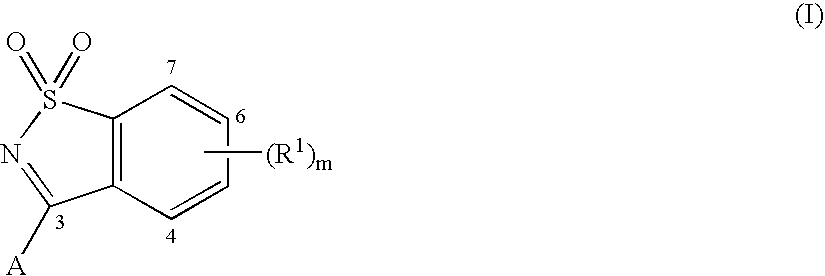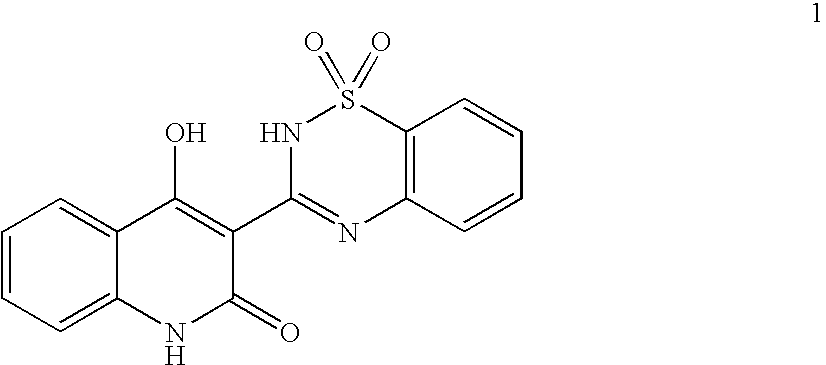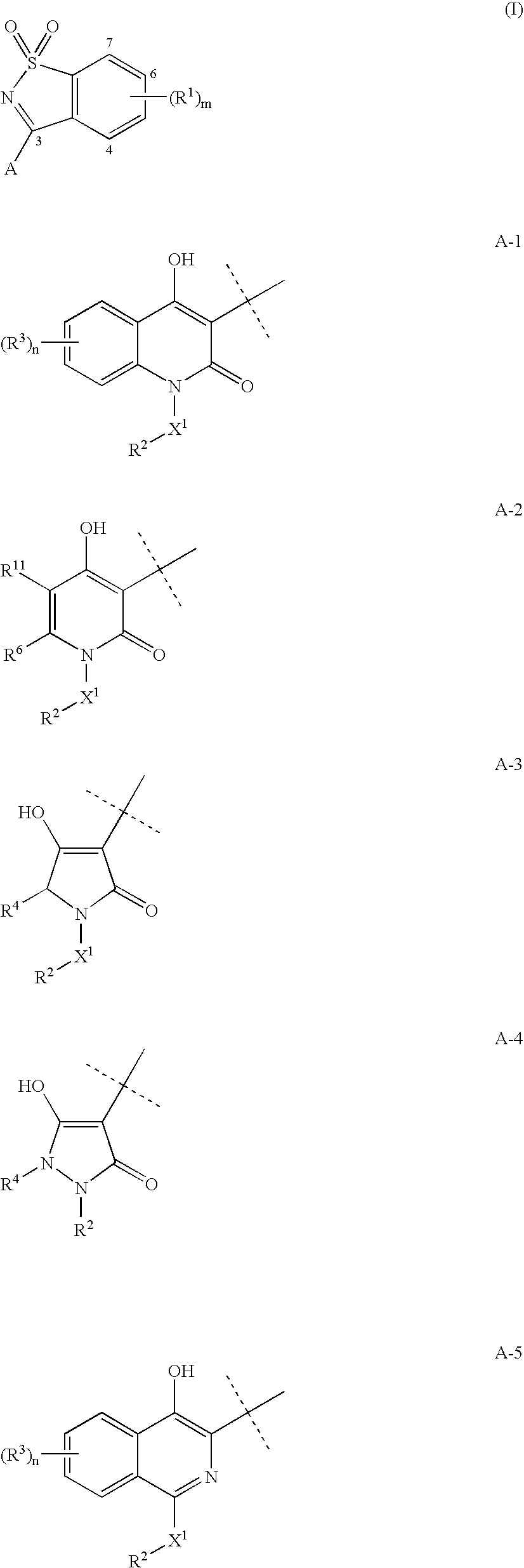Heterocyclic antiviral compounds
a heterocyclic compound and antiviral technology, applied in the field of non-nucleoside compounds, can solve the problems of ribavirin's significant toxicity, known to induce anemia, and temporary effects of ifn therapy
- Summary
- Abstract
- Description
- Claims
- Application Information
AI Technical Summary
Benefits of technology
Problems solved by technology
Method used
Image
Examples
example 1
3-(1,1-Dioxo-1H-1λ6-benzo[d]isothiazol-3-yl)-1-(3-methyl-butyl)-isoquinolin-4-ol (I-1, SCHEME 1)
[0292] step 1—POCl3 (40 mL) was added to a flask containing 4-hydroxy-1-oxo-1,2-dihydro-isoquinoline-3-carboxylic acid methyl ester (2, 5.00 g, 22.8 mmol). After stirring at 70° C. for 3 h, the POCl3 was removed in vacuo, and water was added to the residue. The resulting solid was collected by filtration, and the solid was further washed with water and hexanes then dissolved in DCM. The DCM solution was dried (MgSO4), filtered and the solvent was removed in vacuo to afford 5.10 g, (94% theory) of 3a: LCMS RT 3.6 min, M+H.
[0293] step 2—To a suspension of 3a (1.20 g, 5.05 mmol) in DMF (15 mL) was added Cs2CO3 (1.97 g, 6.06 mmol) followed by CH3I (1.57 mL, 25.5 mmol). After stirring at RT for 20 h, the reaction mixture was diluted with EtOAc and twice washed with water and twice with brine. The organic extract was dried (MgSO4), filtered and the solvent was removed in vacuo to afford 1.25 ...
example 2
3-(1,1-Dioxo-1H-1λ6-benzo[d]isothiazol-3-yl)-6-fluoro-1-(4-fluoro-benzyl)-isoquinolin-4-ol (I-4, SCHEME 3)
[0303] step 1—To a reddish-brown solution of 5-fluoro-isobenzofuran-1,3-dione (11 15.0 g, 90.3 mmol) and isocyano-acetic acid methyl ester (8.21 mL, 90.3 mmol) in THF (120 mL) was added dropwise a solution of 1,8-diazabicyclo[5.4.0]undec-7-ene (13.5 mL, 90.3 mmol) in THF (60 mL). The resulting red solution was stirred at RT for 1.5 h and then quenched with water (150 mL). The THF was removed in vacuo and the resulting aqueous solution was acidified to pH4), filtered and the solvent was removed in vacuo to afford 12a and 12b in a 2.5:1 ratio which was used directly in the next step.
[0304] step 2—To a solution of a mixture of the regioisomeric oxazoles 12a and 12b (24 g, 91 mmol) in MeOH (150 mL) warmed to 55° C. was added con HCl (31 mL). The resulting mixture was stirred at 55° C. for 3.5 h. The reaction mixture was diluted with water, and the resulting solid was collected by ...
example 3
3-(1,1-Dioxo-1H-1λ6-benzo[d]isothiazol-3-yl)-1-(4-fluoro-benzyl)-6-methyl-isoquinolin-4-ol (I-5, SCHEME 2)
[0306] step 1—A mixture of 5-methyl-isobenzofuran-1,3-dione (7, 16.2 g, 100 mmol), glycine (8.25 g, 110 mmol), and xylenes (100 mL) was heated at reflux for 20 h. The resulting suspension was cooled to RT and filtered. The precipitated solid was then washed with water and hexanes to afford 7a which was used in the next step without further purification.
[0307] step 2—To a solution of 7a (20 g, 91 mmol) in MeOH (400 mL) was added H2SO4 (8 mL). The solution was stirred at RT for 2 d. About 200 mL of MeOH was removed in vacuo, and the remaining solution was poured into ice water and the mixture neutralized with saturated aqueous NaHCO3. The resulting solid was then filtered, washed with water and hexanes and dissolved in DME. The organic solution was dried (MgSO4), filtered and the solvent was removed in vacuo to afford 18.1 g (85% theory) of 7b: LCMS RT 2.9 min, did not ionize.
[...
PUM
| Property | Measurement | Unit |
|---|---|---|
| Volume | aaaaa | aaaaa |
| Mass | aaaaa | aaaaa |
| Fraction | aaaaa | aaaaa |
Abstract
Description
Claims
Application Information
 Login to View More
Login to View More - R&D
- Intellectual Property
- Life Sciences
- Materials
- Tech Scout
- Unparalleled Data Quality
- Higher Quality Content
- 60% Fewer Hallucinations
Browse by: Latest US Patents, China's latest patents, Technical Efficacy Thesaurus, Application Domain, Technology Topic, Popular Technical Reports.
© 2025 PatSnap. All rights reserved.Legal|Privacy policy|Modern Slavery Act Transparency Statement|Sitemap|About US| Contact US: help@patsnap.com



